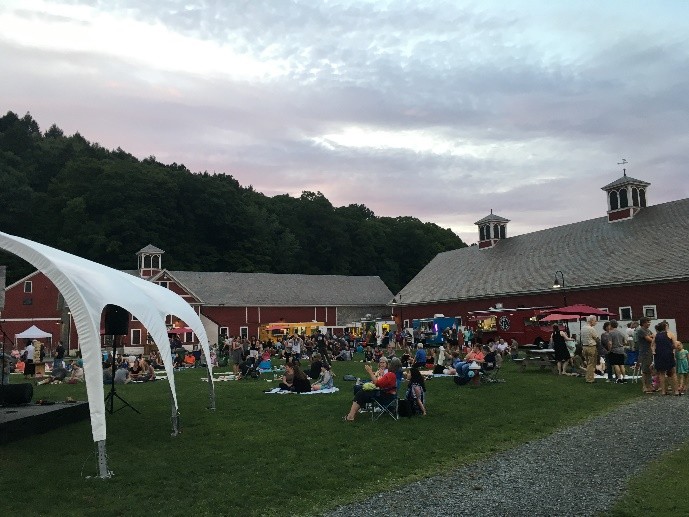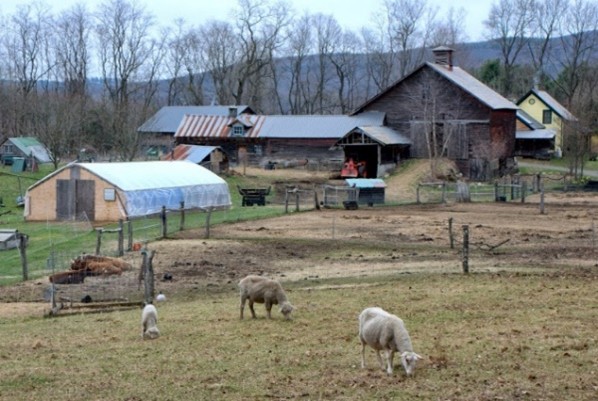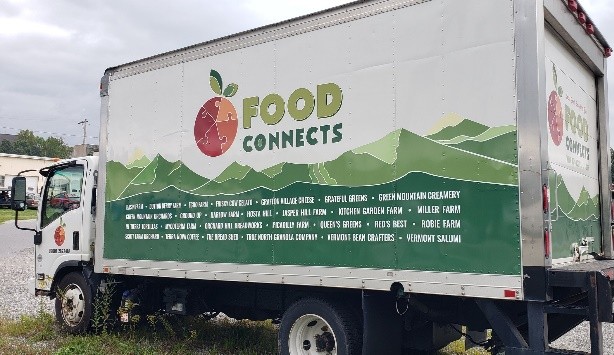economic development
economic sectors
The following section provides a summary of the largest job sectors in the region as well as important historical industries, like agriculture and forestry, that continue to help define the character of the region. Economic sectors are not presented in terms of hierarchy of the number of jobs or relative importance to the regional economy. In 2022, according to the Vermont Department of Labor, the top five industries in Windham County in terms of total number of jobs were Health Care and Social Services (15%), Federal, State or Local Government (14%), Accommodation and Food Services (12%), Retail Trade (12%), and Manufacturing (12%). Federal, State or Local Government sector also includes employees at public schools in the region.
It can be helpful to compare the local labor market with the state as a whole to get a better sense of where Windham County has a higher or lower concentration of certain industries. Generally, the breakdown in jobs by industry in Windham County is comparable to the state as a whole. Sectors that are more concentrated in our region include Construction, Manufacturing, Wholesale Trade, Educational Services, Arts, Entertainment, and Recreation, and Accommodation and Food Services. Many of these industries support the sizable tourism economy in the Windham Region. Notably, there is also a larger percentage of jobs in manufacturing in the Windham County than at the state level. Sectors where there are fewer jobs compared to the state include Finance and Insurance, Professional, Scientific, and Technical Services, Health Care and Social Services, and Federal, State, and Local Government.
healthcare and education
The health care industry is one of the fastest growing sectors nationally and in Vermont and can offer higher-wage opportunities for certain positions. This sector is expected to grow in upcoming years to support the ageing population. Some of the largest service employers in the region are health care providers, including Brattleboro Memorial Hospital and Grace Cottage Hospital. The Brattleboro Retreat, a private psychiatric hospital in Brattleboro, is also a large employer with unique workforce needs as compared to other hospitals in the region. The region benefits from being in close proximity to other prominent health care facilities, such as Dartmouth Hitchcock in Lebanon, New Hampshire. As with other sectors, a main challenge the health care industry faces is being able to recruit employees given the limited supply of housing.
Educational Services accounted for approximately 6 percent of Windham County employment in 2022, (1,208 jobs), which is a decrease of 21 percent since 2012. This number reflects jobs in independent primary and secondary schools and post-secondary institutions only and does not include those employed in public school. Some of this decline in education jobs is likely a result of the closing of Marlboro College in 2020 and the restructuring of the School for International Training in Brattleboro into a low-residency campus. Several independent primary and secondary schools, small private colleges, and public college branch campuses continue to provide a large number of jobs for the region. Some area schools occupy unique market niches: Landmark College and Greenwood School in Putney serve students who learn differently, including students with a learning disabilities, ADHD, and executive function challenges.
Large health care and educational institutions are sometimes referred to as “anchor institutions” because of their significant role in local economies. These institutions usually have large purchasing power, workforces, and real estate holdings and have a vested interest in seeing the communities where they’re located succeed. When these institutions close, it can have a significant ripple effect on the local economy.
manufacturing
From 1930 until the 1980s, manufacturing of intermediate and finished goods was the largest employment sector in the region when it fell behind both service and trade sectors. Currently, manufacturing accounts for 12 percent of the region’s employment (2,196 jobs), which is an increase of approximately 2 percent since 2012. Despite the long-term decline in this sector, it has seemed to stabilized in terms of employment numbers over the last decade. Growth in the non-durable manufacturing sector in recent years has also been able to offset most of the jobs lost as a result of the closure of Vermont Yankee. Manufacturing continues to provide relatively high-paying jobs with an average annual wage of $63,819 in 2022 according to the Vermont Department of Labor.
The manufacturing sector continues to be important to the region’s economy, and includes notable companies in precision manufacturing and optical filters. Large employers include G.S. Precision in Brattleboro and Chroma Technology in Rockingham. The region benefits from being in close proximity to Keene, New Hampshire, which also has a large cluster of precision manufacturing businesses. This proximity creates a larger pool of skilled workers in easy commuting distance to the region that local businesses can recruit from. The region also has several successful value-added food product companies, such as Commonwealth Dairy (Green Mountain Creamery), which is directly attributable to the strength of the region’s agricultural industry and in turn helps support local farmers.
Today, manufacturing activity is concentrated in Brattleboro and Rockingham. Each town has improved land available with municipal water and sewer service and convenient access to I-91 for new or expanding manufacturing enterprises. In Brattleboro the Exit One Industrial Park offers 92 acres and in Bellows Falls the Industrial Park on Route 5 has 31 acres of land.
Chroma technology corporation expansion project

Chroma Technology Corporation is headquartered in Bellows Falls and is a manufacturer of optical filters. In 2016, the company announced a 40,000 square foot expansion project to its facility that was supported by a $100,000 loan from the Town of Rockingham and a $350,000 Community Development Block Grant. As part of the expansion project, Chroma anticipated adding up to 26 new jobs.
The Brattleboro Development Credit Corporation and the Bellows Falls Area Development Corporation encourage and support manufacturing industries in the region. These organizations have worked with state and federal financing sources to secure aid for industrial development. In support of the manufacturing sector, the WRC recognizes the need to plan for and provide locations for new and expanding industries in appropriately-sited industrial parks and other locations that support historic settlement patterns. This is discussed in more detail in the Land Use Chapter.
tourism
The Windham Region has attracted tourists for generations. The three major components of the region’s tourism and recreation industry are the ski resorts, summer and fall tourism, and second homes. Each affects the economy in different ways and provides different types of employment opportunities for residents. The first two are primarily seasonal industries and the last has year-round effects on the economy and cost of housing. Historically, tourism has also been an important recruitment tool for the region as many visitors and seasonal homeowners become permanent residents.
Tourism helps encourage local economic activity and brings more money into the economy from residents outside of our region. According the Vermont Agency of Commerce and Community Development, the state welcomes over 13 million visitors each year that account for roughly $3 billion in annual spending. Businesses that have benefited from growth related to tourism include arts, entertainment, lodging, restaurants, gas stations, retail and outdoor equipment shops, construction and building-related industries, and maintenance and repair services. In addition, the businesses and amenities that attract visitors also benefit year-round residents and add to a quality of life in the region that would be difficult to support without tourism.
The tourism industry cluster includes Accommodation and Food Services, Retail Trade, and Arts, Entertainment, and Recreation sectors. As of 2022, approximately 2,287 residents in Windham county were employed in Accommodation and Food Services, 2,211 in Retail Trade, and 294 in Arts, Entertainment, and Recreation. In total, these sectors account for 4,792 jobs or roughly 25% of the total jobs in Windham County. However, the average wages for these sectors are substantially lower than the county-wide average of $53,531. Generally, employment in the leisure/hospitality sector is also seasonal in nature and employees may not have a reliable source of year-round income. It is also common for service sector jobs to have non-traditional work schedules, which may include early morning, longer shifts, weekend, or evening hours.
Reduced snowfall amounts during some winters and industry changes have challenged the capital-intensive ski business and contributed to a decrease in the total number of operating ski areas. The surviving resorts, in particular Mt. Snow and Stratton, have grown in size and offerings to the point that in peak seasons, the resort area populations rival the region’s two traditional centers of Brattleboro and Rockingham. There has also been an increase in development and promotion of other recreational activities during non-winter seasons to attract visitors year-round, like golfing and mountain biking. This has an impact on the viability of tourism-related businesses and municipal facilities and services during non-winter seasons.
The region’s rich heritage and culture create further tourism opportunities. Towns have the advantage of using existing assets and encouraging the preservation of the very attributes that distinguish Vermont to attract visitors. With its wealth of historic sites, traditional villages, and cultural attractions, the Windham Region is well positioned to continue to promote heritage tourism.
creative sector

at the Retreat Farm, Brattleboro
There is a growing recognition of the importance of arts and creative endeavors for the regional economy. This includes the arts and culture industry that gets grouped with the tourism economic cluster, but also artisan food producers, graphic designers, museum staff, and media producers. In 2021, the Vermont Creative Network issued Create VT: Action Plan for Vermont’s Creative Sector. The plan provides a roadmap for strengthening the creative sector statewide and also looks at existing jobs in this sector in the different regions of the state. The plan estimates there are 4,158 creative sector jobs in southern Vermont (Bennington County and Windham County).
According to the report, investing in the creative economy has many benefits including diversifying local economies, increasing jobs, building community, and attracting tourists and new residents. It is estimated that the arts and culture sector adds $1.1 billion to Vermont’s GDP, ranking this sector third in the state behind only retail and construction. Nearly 50 percent of creative sector workers in Vermont are self-employed or in microbusinesses. A stronger small businesses environment can help the economy be more resilient. For more discussion on arts and cultural resources in the region, see the Educational, Cultural, and Historical Resources Chapter.
agriculture

Agriculture plays an important role in defining the region's landscape and has long contributed to the stability and diversity of the Windham Region’s economy. The trend in agriculture throughout Vermont is for new farmers to seek smaller-scale, diversified opportunities in order to remain competitive with larger operations. An exception to this trend is that conventional dairy operations are becoming fewer in number with remaining farms becoming larger.
Some of the new market opportunities for farmers are direct sales to restaurants and consumers at farmers’ markets and creating value-added products. The Northeast Organic Farming Association of Vermont currently lists seasonal farmers’ markets in our region in Brattleboro (including a winter market), Rockingham, Newfane, Putney, Townshend, and Londonderry. One aspect of the cultural heritage of Vermont is its long history of family-based farms and agriculture and agri-tourism attracts tourists and brings in additional revenue for farmers, for example with pick-your-own operations.
local food hub model

Food Connects is a non-profit organization based in Brattleboro that has developed a food hub distribution model that better connects wholesale customers in New England with regional food producers. This model has opened up new market opportunities for smaller farms in the region.
The local agricultural industry faces several challenges, including a decrease in available farmland and the impacts of climate change on the growing season. The agricultural economy relies on having a critical mass of farms and farmland to sustain the businesses that support the agricultural industry. As the number of farms decreases, it can be challenging to sustain these associated businesses. Between 2012 – 2017 there was a decrease in the total number of farms in Windham County from 447 to 414. There was also a corresponding decline in total acreage in agricultural use from 50,765 acres to 44,844 acres, a decrease of nearly 12 percent. It is critical to support land use planning at the local level that works to protect land with prime agricultural soils from development pressure and to support conservation efforts that preserve agricultural lands. The majority of farms (76.6 percent) in 2017 had less than $20,000 in sales showing that most of the farms in the region are small-scale operations.
TABLE 5-1: WINDHAM County Farm land and farm sales, 2012 – 2017
| Windham County | 2012 | 2017 |
|---|---|---|
| Total Farms | 447 | 414 |
| Land in Agricultural Use | 50,765 acres | 44,844 acres |
| Farm Sales: Less than $20,000 | 341 | 317 |
| Farm Sales: $20,000 - $99,999 | 68 | 62 |
| Farm Sales: More than $100,000 | 38 | 35 |
Source: United States Department of Agriculture, 2012 and 2017 Census of Agriculture
forestry
Forests are one of the region's most important economic resources. Approximately 86 percent of the region is forested and all but a small percentage of that land supports periodic commercial harvests. These forests provide a livelihood for many people through wood harvesting, wood products, recreation, hunting, and maple products. A more detailed description of the importance of forestlands can be found in the Natural Resources Chapter.
In 2021, Windham County ranked first in the state for total sawlog and veneer log harvest with 17.179 million board feet. This is a decline from the 22.996 million board feet harvested in Windham County in 2010. The next closest county for total harvest in 2021 was Windsor County with 10.815 million board feet. A number of secondary wood-related industries including construction materials, furniture and toy manufacture, cabinetry, boat building, and musical instruments are also located in the region.
The region’s forest industry is threatened by a number of trends. The industry is becoming less economically viable due to market trends including global market competition, outsourcing of production, consolidation, and rising business costs, especially associated with establishing a new business. Similar to other industries, forestry businesses are also struggling with workforce recruitment as many long-term workers retire. The saw mill directory maintained by the Vermont Department of Forests, Parks and Recreation shows 75 mills in the state as of 2023, which is a 28 percent decline from the 105 active mills in 2008. Increasingly, hardwood is exported as a raw material causing a loss of jobs from the associated value-added milling process.
According to the Vermont Natural Resources Council, the Windham Region saw a nearly 20 percent decline in the number of woodland acres from 2010 to 2020 from 81,602 acres to 65,723 acres. There was a similar 19 percent decline in woodland acreage in parcels greater than 50 acres in size. Trends that are impacting this decline in woodland acreage include rising property values and the conversion of forested lands for development. Changing climatic conditions are also making it more difficult for some native species to survive and allowing for the spread of invasive species, such as the emerald ash borer and the hemlock woolly adelgid.
TABLE 5-2: WINDHAM region woodland acreage, 2010 - 2020
| Windham Region | 2010 | 2020 | Pct. Change |
|---|---|---|---|
| Acreage in Woodland Parcels | 81,602 acres | 65,723 acres | -19.5% |
| Acreage in Woodland Parcels Greater than 50 acres in Size | 65,414 acres | 53,007 acres | -19% |
Source: Vermont Natural Resources Council Parcelization Website (https://vtforesttrends.vnrc.org/explorer)
In 2013, students at The Conway School produced a report for the WRC entitled Our Working Landscape: Woodlands of the Windham Region. The Conway School is a graduate-level program in sustainable landscape planning and design located in Northampton, Massachusetts. The report explores how the working landscape may be maintained amidst recent economic, social, and environmental trends.
